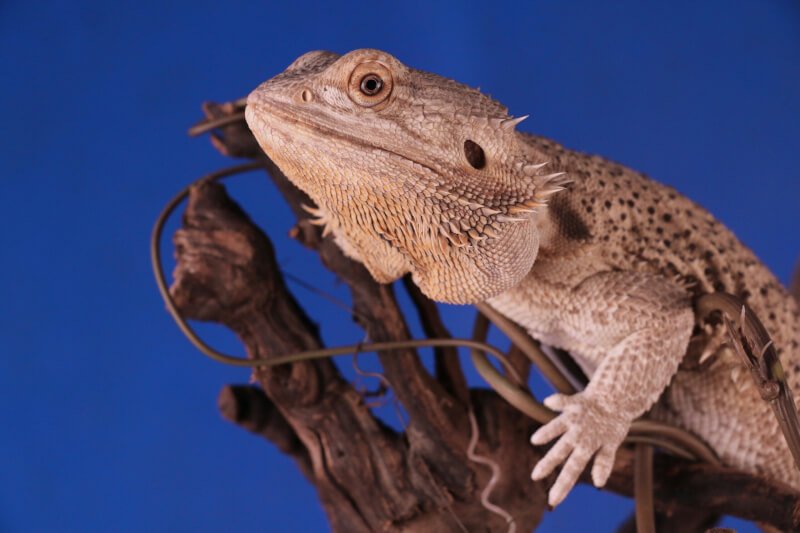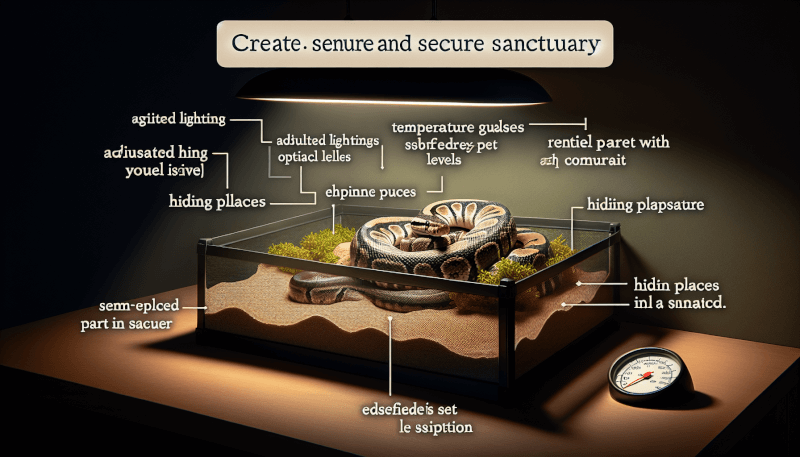If you have a nervous snake as a pet, providing it with a secure and calming environment is crucial for its well-being. Snakes are known for their sensitivity to their surroundings, and a tense environment can further exacerbate their anxiety. By ensuring their terrarium is set up to mimic their natural habitat, incorporating hiding spots, and maintaining consistent temperature and lighting, you can create a safe haven that promotes relaxation and helps your nervous snake feel more at ease.

Understanding a Nervous Snake
Understanding the behavior and needs of a nervous snake is crucial in providing the best care and environment for its well-being. Nervousness in snakes can be caused by various factors, such as genetics, past experiences, or inadequate handling. It is important to approach a nervous snake with patience, respect, and understanding.
Providing the Proper Cage Setup
To create a secure and comforting habitat for a nervous snake, it is essential to focus on the following aspects of cage setup.
Choosing an Appropriate Cage
Selecting the right cage size is vital for a nervous snake. It should be spacious enough for the snake to move around and stretch out comfortably. A larger cage can help reduce stress and promote a sense of security.
Creating a Hideout
Including multiple hideouts in the cage is essential for a nervous snake. These hiding spots can be created using various materials such as rocks, logs, or commercially available snake hides. These hiding areas provide a safe retreat for the snake and help alleviate anxiety.
Maintaining Optimal Temperature and Humidity
Ensuring the proper temperature and humidity levels in the cage is critical for a nervous snake. Research the specific needs of the snake species to provide the ideal environment. Use thermometers and hygrometers to monitor and maintain the appropriate conditions.
Setting Up Lighting
Proper lighting is essential for the well-being of a nervous snake. Use full-spectrum UVB lighting to provide natural light and promote the snake’s physical health. Create a day and night cycle by using timers to mimic the natural lighting patterns.
Arranging Substrate Material
Choosing the appropriate substrate material is crucial for both the snake’s comfort and hygiene. There are various suitable options available, such as aspen bedding, reptile carpet, or paper towels. Avoid using substrates that can cause harm if ingested, such as sand or gravel.
Handling Techniques
Using the right handling techniques is crucial for a nervous snake’s comfort and trust-building. It is important to proceed with patience and gentleness to minimize stress and avoid any potential harm to the snake.
Approaching the Snake
Approaching a nervous snake should be done slowly and calmly. Avoid sudden movements or loud noises that may startle the snake. Give the snake time to observe and adjust to your presence. Make sure to have clean hands, free from any scents that might cause distress to the snake.
Using a Snake Hook
Using a snake hook can be beneficial when handling a nervous snake, especially during initial interactions. Gently and slowly place the hook under the snake’s body to provide support, allowing the snake to feel secure and reducing the risk of accidental bites.
Allowing the Snake to Explore
Give the nervous snake the opportunity to explore its surroundings at its own pace. Avoid forcing the snake to come out of its hiding spot or handling it if it shows signs of stress. When the snake feels comfortable, it will naturally start exploring on its own.
Avoiding Sudden Movements
When handling a nervous snake, it is important to move slowly and smoothly, avoiding any sudden motions. Sudden movements can startle the snake and trigger defensive behaviors, such as striking or biting. Maintaining a calm and gentle approach will help the snake feel safe and secure.
Creating a Calming Environment
Providing a calming environment is essential for a nervous snake’s overall well-being and mental health. Creating a peaceful and stress-free living space will help the snake feel secure and reduce anxiety levels.
Minimizing Noise and Disturbance
Keep the snake’s environment quiet and free from excessive noise or disturbance. Loud noises and sudden vibrations can be unsettling for a nervous snake. Place the snake’s cage in a serene area away from high traffic or noisy locations.
Establishing a Routine
Nervous snakes thrive on routine and consistency. Establish a daily routine for feeding, cleaning, and handling, and try to stick to it as much as possible. Predictability and structure can help alleviate stress and provide a sense of security for the snake.
Providing Adequate Hiding Spots
Ensure that the snake’s cage has ample hiding spots to help it feel safe and secure. Hiding spots can be created using various materials like rocks, logs, or commercially available hides. Place these hiding spots in different areas of the cage to offer the snake options for retreat.
Avoiding Overhandling
While handling a nervous snake is essential for bonding and trust-building, it is crucial to avoid overhandling. Too much handling can increase stress levels, making the snake more anxious and agitated. Limit handling sessions to short periods and gradually increase the duration over time.

Dealing with Feeding and Health Issues
Nervous snakes may face challenges when it comes to feeding and maintaining their overall health. Here are some tips to ensure their well-being.
Ensuring a Consistent Feeding Schedule
Establish a consistent feeding schedule for the nervous snake. Following a regular routine will help the snake anticipate and expect food at specific times, reducing anxiety and promoting healthy feeding habits. Research the appropriate diet for the snake’s species and provide a balanced and nutritionally complete meal.
Choosing the Right Diet
Choosing the right diet is crucial for a nervous snake’s health. Research the specific dietary requirements of the snake species and provide a varied diet that includes appropriate prey items. It is recommended to feed pre-killed prey to reduce the risk of injury to the snake and minimize stress.
Consulting a Veterinarian
Regular veterinary check-ups are important for the overall health and well-being of a nervous snake. If you notice any abnormal behaviors or signs of illness, consult a reptile-experienced veterinarian. They can provide professional advice and ensure that the snake is in good health.
Monitoring Signs of Stress or Illness
Observing the nervous snake for any signs of stress or illness is crucial. Common signs of stress include loss of appetite, excessive hiding, unusual aggression, or changes in skin coloration. Monitor the snake’s behavior and physical condition closely, and seek veterinary help if any concerns arise.
Socialization and Exposure
Gradual exposure to new environments and interactions with other animals can help a nervous snake become more comfortable and confident. However, it is important to introduce these experiences gradually and carefully to avoid overwhelming the snake.
Gradual Introduction to New Environments
When exposing the snake to new environments, start with small and controlled introductions. Gradually increase the exposure time as the snake becomes more comfortable. This will help the snake adjust to new sights, sounds, and smells without causing undue stress.
Introducing Other Animals
If you have other animals in your household, such as cats or dogs, introduce them to the snake cautiously and under close supervision. Allow the snake to observe the other animals from a safe distance before gradually increasing their exposure. Monitor their interactions carefully to ensure the safety of all animals involved.
Exposing the Snake to Different Stimuli
Expose the snake to various stimuli to help desensitize it to potential stressors. This can include gentle handling, playing soft music, or allowing the snake to explore different textures within a controlled environment. Gradual exposure will help the snake become more tolerant and confident in different situations.

Handling Aggressive Behaviors
In rare cases, a nervous snake may exhibit aggressive behaviors. It is important to identify and address these behaviors promptly to ensure the safety of both the snake and its caretaker.
Identifying Aggression
Aggressive behaviors in a nervous snake can include hissing, lunging, or biting. It is essential to understand that aggressive behaviors often stem from fear or feeling threatened. Pay attention to the snake’s body language and respond accordingly, avoiding any confrontational behavior.
Seeking Professional Help
If the snake’s aggressive behaviors persist or escalate, it is advisable to seek professional help. An experienced reptile veterinarian or a reptile behaviorist can provide guidance and techniques to address the aggression effectively and ensure the safety of all involved.
Using Behavioral Techniques
Behavioral techniques, such as positive reinforcement training or desensitization exercises, can be beneficial in addressing aggressive behaviors. Rewarding calm and non-aggressive behavior and gradually exposing the snake to potential triggers can help modify its response over time.
Training and Behavioral Modification
Training and behavioral modification can play a significant role in helping a nervous snake become more comfortable and trusting.
Using Positive Reinforcement
Positive reinforcement techniques, such as rewarding the snake with treats or praise for calm behavior, can be effective in encouraging positive associations. Gradually increase the difficulty of training tasks, promoting the snake’s confidence and trust.
Implementing Desensitization Techniques
Desensitization exercises involve gradually exposing the snake to potential triggers in a controlled and gradual manner. By repeatedly exposing the snake to mildly stressful situations and rewarding calm behavior, it can learn to react more calmly and feel less threatened over time.
Promoting Trust and Bonding
Building trust and bonding with a nervous snake takes time and patience. Spend quality time with the snake, allowing it to explore its surroundings while providing a safe and secure environment. Handle the snake gently and calmly, respecting its boundaries and gradually increasing handling sessions as trust develops.

Resources for Further Assistance
If you require additional assistance in caring for a nervous snake, there are various resources available to provide guidance and support.
Joining Reptile Enthusiast Communities
Joining online forums, social media groups, or local reptile enthusiast clubs can provide a wealth of knowledge and support from experienced snake keepers. Engage in discussions, ask for advice, and learn from the experiences of others who have dealt with nervous snakes.
Seeking Help from Snake Experts or Breeders
Snake experts and experienced breeders have a wealth of knowledge when it comes to snake care and behavior. Reach out to them for guidance and advice specific to your nervous snake’s needs. They can offer valuable insights and help navigate any challenges you may encounter.
Consulting Reptile Care Books or Websites
There are numerous reptile care books and reputable websites available that provide comprehensive information on snake care, handling, and behavioral modification. These resources can be a valuable source of information and guidance for nervous snake owners.
By understanding the needs and behavior of a nervous snake, providing the proper cage setup, employing appropriate handling techniques, creating a calming environment, and addressing feeding and health issues, you can help your nervous snake feel secure and thrive in its new environment. With patience, love, and proper care, your nervous snake can gradually become more confident and comfortable, forming a special bond with its caretaker. Remember, each snake is unique, so always pay attention to your snake’s individual needs and adjust your approach accordingly.


